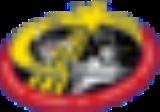
STS-124
Encyclopedia
STS-124 was a Space Shuttle
mission, flown by Space Shuttle Discovery
to the International Space Station
. Discovery launched on 31 May 2008 at 17:02 EDT
, moved from an earlier scheduled launch date of 25 May 2008, and landed safely at the Kennedy Space Center
's Shuttle Landing Facility, at 11:15 EDT on 14 June 2008. The mission is also referred to as ISS-1J by the ISS program.
.jpg) "I’m really fortunate to be given the crew members that I have on this mission. It’s myself and six others. We do swap one of our crew members with the expedition crew member on board. So Greg goes up, Greg stays on station and Garrett comes home. But the crew that was assigned to me—I’m really fortunate to have some really talented people. Ken Ham, as a pilot, knows the orbiter better than anybody I’ve seen. This is his first flight. My lead EVA crew member is Mike Fossum who did three spacewalks on my previous flight, STS-121. We’ve flown together before. I have all the confidence in the world in his ability to execute these EVAs. Karen Nyberg, my MS1, sits on the flight deck for ascent and entry. She’s also the lead for all the robotic arm operations. She’ll be flying three robotic arms in space, incredibly motivated, well ahead of the game and I expect great things from her. Ron Garan is my flight engineer, a colonel in the Air Force. This is going to be his first time in space as well as is Karen’s and Ken’s and he’s doing three spacewalks. So he's got a lot on his plate. He’s been doing great during training and he’s going to have the opportunity to prove himself during these three spacewalks. I kind of wish it was me getting to go outside. I can’t do that, but we expect great things from Ron as well. And then I have Aki Hoshide, our Japanese crew member, who grew up in New Jersey kind of like me. That’s an interesting thing about our flight—we have four people from New Jersey on the mission. I look at Aki as the payload commander. He is responsible for that Japanese laboratory and he has taken on that responsibility as completely as I could have hoped for. All through our training he’s been very much focused on the Japanese lab, making sure it’s ready to go, making sure we’re completely trained on the systems and everything we have to do. I’ve given him a lot of responsibility and he’s completely taken it on."
"I’m really fortunate to be given the crew members that I have on this mission. It’s myself and six others. We do swap one of our crew members with the expedition crew member on board. So Greg goes up, Greg stays on station and Garrett comes home. But the crew that was assigned to me—I’m really fortunate to have some really talented people. Ken Ham, as a pilot, knows the orbiter better than anybody I’ve seen. This is his first flight. My lead EVA crew member is Mike Fossum who did three spacewalks on my previous flight, STS-121. We’ve flown together before. I have all the confidence in the world in his ability to execute these EVAs. Karen Nyberg, my MS1, sits on the flight deck for ascent and entry. She’s also the lead for all the robotic arm operations. She’ll be flying three robotic arms in space, incredibly motivated, well ahead of the game and I expect great things from her. Ron Garan is my flight engineer, a colonel in the Air Force. This is going to be his first time in space as well as is Karen’s and Ken’s and he’s doing three spacewalks. So he's got a lot on his plate. He’s been doing great during training and he’s going to have the opportunity to prove himself during these three spacewalks. I kind of wish it was me getting to go outside. I can’t do that, but we expect great things from Ron as well. And then I have Aki Hoshide, our Japanese crew member, who grew up in New Jersey kind of like me. That’s an interesting thing about our flight—we have four people from New Jersey on the mission. I look at Aki as the payload commander. He is responsible for that Japanese laboratory and he has taken on that responsibility as completely as I could have hoped for. All through our training he’s been very much focused on the Japanese lab, making sure it’s ready to go, making sure we’re completely trained on the systems and everything we have to do. I’ve given him a lot of responsibility and he’s completely taken it on."
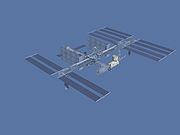
 STS-124 delivered the Pressurized Module (PM) of the Japanese Experiment Module
STS-124 delivered the Pressurized Module (PM) of the Japanese Experiment Module
(JEM), called Kibō, to the International Space Station (ISS). Kibō was berthed to the Harmony module and the pressurized section of the JEM Experiment Logistics Module, brought up by the STS-123
crew, was moved from Harmony to the JEM-PM. The Japanese Remote Manipulator System, a robotic arm, was also delivered by STS-124 and attached to Kibō. The entire Kibō laboratory is being brought up over three missions.
Discovery carried with it replacement parts in a mid-deck locker for a malfunctioning toilet on the International Space Station. The crew had been using other facilities for waste until the new replacement parts were installed on the Zvezda module of the ISS.
Flying with the STS-124 crew was an action figure of Buzz Lightyear
. Ken Ham, pilot of the STS-124 mission, brought with him episodes of ESPN Radio's Mike and Mike in the Morning, and a plastic microphone stand with the ESPN logo on it. Along with those, a yellow jersey from Lance Armstrong
's record-setting seven victories at the Tour de France bicycle race, the backup jersey Eli Manning
took to the Super Bowl, and the last jersey that American Major League Baseball's Craig Biggio
wore in a game were placed inside the orbiter's lockers.
With the completion of STS-124, the next permanent pressurized module would not be delivered to the ISS by a Space Shuttle until STS-130
brought up Tranquility in February 2010.
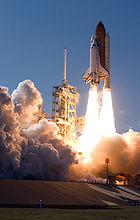 On 26 April 2008 Discovery
On 26 April 2008 Discovery
was rolled over to the Vehicle Assembly Building
(VAB) from its processing bay in the Orbiter Processing Facility
. Once in the VAB it was lifted vertically and mated with its external tank
and solid rocket boosters
on 28 April 2008. At the end of a week long prep schedule on 2 May 2008 at 23:47 EDT
the stack was rolled out to launch pad 39A
on top the Mobile Launch Platform. Carried by the Crawler Transporter, Discovery arrived and was secured at LC-39A
on 3 May 2008 at 06:06 EDT
. The payload canister containing the JEM
was rolled out to the Payload Changeout Room at the pad on 29 April 2008 and was later installed into Discovery' s payload bay on 5 May 2008. The STS-124 crew arrived at Kennedy Space Center
on 6 May 2008 for the 3-day Terminal Countdown Demonstration Test
and returned to Johnson Space Center
on 9 May 2008 after completion of the launch dress rehearsal. After many flight readiness review tests, Discovery was given a go for a 31 May 2008 launch. Discovery launched on 31 May 2008 at 21:02 UTC. The following is the expected timeline and is subject to change.
at 17:02 EDT local time. Debris from the fuel tank was minimal.
"While we've all prepared for this event today, the discoveries from Kibo will definitely offer hope for tomorrow," said Discovery's commander Mark Kelly just before launch. "Now stand by for the greatest show on Earth."
is an exhaust by-product of the solid rocket boosters. Repairs to the trench were completed before the STS-125
mission's then scheduled launch attempt on 8 October 2008. In fact STS-125 finally launched in May 2009, and in the meantime STS-126
(November 2008) and STS-119
(March 2009) had both been successfully launched from pad 39A.
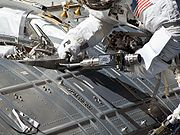 Mike Fossum and Ron Garan completed a six hour, forty-eight minute spacewalk at 23:10 UTC. During the excursion, the pair retrieved the Orbiter Boom Sensor System
Mike Fossum and Ron Garan completed a six hour, forty-eight minute spacewalk at 23:10 UTC. During the excursion, the pair retrieved the Orbiter Boom Sensor System
, serviced and inspected components of a Solar Alpha Rotary Joint and prepared the JEM-PS component of the Kibō laboratory for installation. Karen Nyberg and Akihiko Hoshide, using the station’s robotic arm, removed the JEM-PS from the shuttle’s payload bay and latched it in place on the Harmony node, completing the task at 23:01 UTC.
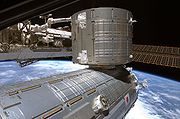 The hatch to the Kibō lab was opened at 21:05 UTC. The crew also repaired the malfunctioning ISS toilet
The hatch to the Kibō lab was opened at 21:05 UTC. The crew also repaired the malfunctioning ISS toilet
.
 Fossum and Garan completed the second STS-124 spacewalk. The 7-hour, 11-minute excursion ended at 22:15 UTC. Prior to heading outside spacewalker Garan stated "Mike and I are getting ready to go out the door for our second spacewalk today. It's going to be a wonderful day."
Fossum and Garan completed the second STS-124 spacewalk. The 7-hour, 11-minute excursion ended at 22:15 UTC. Prior to heading outside spacewalker Garan stated "Mike and I are getting ready to go out the door for our second spacewalk today. It's going to be a wonderful day."
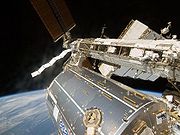 Hoshide and Nyberg moved two of the six joints on the Japanese Kibō lab's robotic arm for the first time, maneuvering them very slightly with a series of commands. With the mission at its midpoint astronaut Karen Nyberg commented that "the week has gone way too fast."
Hoshide and Nyberg moved two of the six joints on the Japanese Kibō lab's robotic arm for the first time, maneuvering them very slightly with a series of commands. With the mission at its midpoint astronaut Karen Nyberg commented that "the week has gone way too fast."
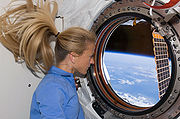 Fossum and Garan conducted the third and final spacewalk, replacing an empty nitrogen tank and collecting a sample of debris from the solar array.
Fossum and Garan conducted the third and final spacewalk, replacing an empty nitrogen tank and collecting a sample of debris from the solar array.
"It's amazing what's going on up here," said Chamitoff. "This is just the beginning. Overall, the mission's been a great success," said Kelly from space. "I certainly have a great crew and they're well trained, but there's also a little luck involved."
Afterwards the crew of Discovery conducted the late inspection of the shuttle's Thermal Protection System that was unable to be performed as usual on Flight Day 2, due to the size of the Kibo Pressurized Module.
During the day, pilot Kenneth Ham conducted an interview with Mike Greenberg and Mike Golic
of ESPN
, to be aired on their radio show, Mike and Mike in the Morning
, the following morning on ESPN Radio
and ESPN2
.
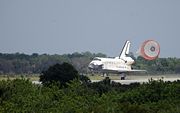 The crew worked through their lengthy list of deorbit preparations, which continued for most of the day. They closed the payload bay doors at 11:30 UTC, which took place without incident. All of Discovery's systems were nominal, and with the weather looking very good at KSC
The crew worked through their lengthy list of deorbit preparations, which continued for most of the day. They closed the payload bay doors at 11:30 UTC, which took place without incident. All of Discovery's systems were nominal, and with the weather looking very good at KSC
the deorbit burn took place on schedule at 14:10 UTC for landing on runway 15 at 15:15 UTC.
At 12:00 UTC, the decision was made to use runway 15 rather than 33. This decision was made based on the sun glare that would be present on the Commander's window as he lined up Discovery with the runway.
were scheduled and completed during STS-124. The cumulative time in extra-vehicular activity during the mission was 20 hours and 32 minutes.
.
Each track is specially chosen, often by their families, and usually has a special meaning to an individual member of the crew, or is applicable to their daily activities.
was the designation given to the Contingency Shuttle Crew Support mission which would have been launched in the event that Discovery
became disabled during STS-124. It would have been a modified version of the STS-126
mission of Endeavour
, which would have involved the launch date being brought forward. The crew for this mission would have been a four-person subset of the full STS-126 crew, namely:
Space Shuttle
The Space Shuttle was a manned orbital rocket and spacecraft system operated by NASA on 135 missions from 1981 to 2011. The system combined rocket launch, orbital spacecraft, and re-entry spaceplane with modular add-ons...
mission, flown by Space Shuttle Discovery
Space Shuttle Discovery
Space Shuttle Discovery is one of the retired orbiters of the Space Shuttle program of NASA, the space agency of the United States, and was operational from its maiden flight, STS-41-D on August 30, 1984, until its final landing during STS-133 on March 9, 2011...
to the International Space Station
International Space Station
The International Space Station is a habitable, artificial satellite in low Earth orbit. The ISS follows the Salyut, Almaz, Cosmos, Skylab, and Mir space stations, as the 11th space station launched, not including the Genesis I and II prototypes...
. Discovery launched on 31 May 2008 at 17:02 EDT
Eastern Time Zone
The Eastern Time Zone of the United States and Canada is a time zone that falls mostly along the east coast of North America. Its UTC time offset is −5 hrs during standard time and −4 hrs during daylight saving time...
, moved from an earlier scheduled launch date of 25 May 2008, and landed safely at the Kennedy Space Center
Kennedy Space Center
The John F. Kennedy Space Center is the NASA installation that has been the launch site for every United States human space flight since 1968. Although such flights are currently on hiatus, KSC continues to manage and operate unmanned rocket launch facilities for America's civilian space program...
's Shuttle Landing Facility, at 11:15 EDT on 14 June 2008. The mission is also referred to as ISS-1J by the ISS program.
Crew
Crew notes
- Stephen G. BowenStephen G. BowenStephen Gerard Bowen is a US Navy submariner and a NASA astronaut; he was the second submariner to travel into space. Bowen has been on three spaceflights, all of which were Space Shuttle missions to the International Space Station...
was originally assigned to STS-124 but was moved to STS-126STS-126-Crew notes:Originally scheduled to fly on STS-126 was Joan E. Higginbotham, who was a mission specialist on STS-116. On 21 November 2007, NASA announced a change in the crew manifest due to Higginbotham's decision to leave NASA to take a job in the private sector. Stephen G...
to allow this mission to rotate an ISS crew member. Bowen was scheduled to perform the EVAExtra-vehicular activityExtra-vehicular activity is work done by an astronaut away from the Earth, and outside of a spacecraft. The term most commonly applies to an EVA made outside a craft orbiting Earth , but also applies to an EVA made on the surface of the Moon...
s on the flight along with Fossum. Garan took his place for the EVAs.
Commander Kelly discusses the crew
.jpg)
- Gregory Chamitoff brought the first bagels into space: 3 bags (18 sesame seed bagels) with him.
Mission parameters
- MassMassMass can be defined as a quantitive measure of the resistance an object has to change in its velocity.In physics, mass commonly refers to any of the following three properties of matter, which have been shown experimentally to be equivalent:...
: - Orbiter liftoff: 269123 pounds (122,072.1 kg)
- Orbiter landing: 203320 pounds (92,224.4 kg)
- PerigeePerigeePerigee is the point at which an object makes its closest approach to the Earth.. Often the term is used in a broader sense to define the point in an orbit where the orbiting body is closest to the body it orbits. The opposite is the apogee, the farthest or highest point.The Greek prefix "peri"...
: 177 nautical miles (327.8 km) - Apogee: 166 nautical miles (307.4 km)
- InclinationInclinationInclination in general is the angle between a reference plane and another plane or axis of direction.-Orbits:The inclination is one of the six orbital parameters describing the shape and orientation of a celestial orbit...
: 51.6 degrees - PeriodOrbital periodThe orbital period is the time taken for a given object to make one complete orbit about another object.When mentioned without further qualification in astronomy this refers to the sidereal period of an astronomical object, which is calculated with respect to the stars.There are several kinds of...
: 91min
Mission payloads


Japanese Experiment Module
The Japanese Experiment Module , also known with the nickname , is a Japanese science module for the International Space Station developed by JAXA. It is the largest single ISS module. The first two pieces of the module were launched on space shuttle missions STS-123 and STS-124...
(JEM), called Kibō, to the International Space Station (ISS). Kibō was berthed to the Harmony module and the pressurized section of the JEM Experiment Logistics Module, brought up by the STS-123
STS-123
-Mission parameters:* Mass:* Orbiter liftoff: * Orbiter landing: * Perigee: 336 kilometers * Apogee: 346 kilometers * Inclination: 51.6 degrees* Period: 91.6min-Mission payloads:...
crew, was moved from Harmony to the JEM-PM. The Japanese Remote Manipulator System, a robotic arm, was also delivered by STS-124 and attached to Kibō. The entire Kibō laboratory is being brought up over three missions.
Discovery carried with it replacement parts in a mid-deck locker for a malfunctioning toilet on the International Space Station. The crew had been using other facilities for waste until the new replacement parts were installed on the Zvezda module of the ISS.
Flying with the STS-124 crew was an action figure of Buzz Lightyear
Buzz Lightyear
Buzz Lightyear is a character and the main deuteragonist of the Toy Story franchise. Buzz is a space ranger action figure and the co-leader of Andy's Room. He has also appeared in the movie Buzz Lightyear of Star Command: The Adventure Begins and the television series spin-off Buzz Lightyear of...
. Ken Ham, pilot of the STS-124 mission, brought with him episodes of ESPN Radio's Mike and Mike in the Morning, and a plastic microphone stand with the ESPN logo on it. Along with those, a yellow jersey from Lance Armstrong
Lance Armstrong
Lance Edward Armstrong is an American former professional road racing cyclist who won the Tour de France a record seven consecutive times, after having survived testicular cancer. He is also the founder and chairman of the Lance Armstrong Foundation for cancer research and support...
's record-setting seven victories at the Tour de France bicycle race, the backup jersey Eli Manning
Eli Manning
Eli Nelson Manning is an American football quarterback for the New York Giants of the National Football League. He is the younger brother of NFL quarterback Peyton Manning and the son of former NFL quarterback Archie Manning...
took to the Super Bowl, and the last jersey that American Major League Baseball's Craig Biggio
Craig Biggio
Craig Alan Biggio is a former Major League Baseball second baseman, catcher, and outfielder. He played his entire 20-year baseball career with the Houston Astros . He ranks 21st all-time with 3,060 career hits, and is the ninth player in the 3000 hit club to get all his hits with the same team. He...
wore in a game were placed inside the orbiter's lockers.
With the completion of STS-124, the next permanent pressurized module would not be delivered to the ISS by a Space Shuttle until STS-130
STS-130
STS-130 was a NASA Space Shuttle mission to the International Space Station . 's primary payloads were the Tranquility module and the Cupola, a robotic control station with six windows around its sides and another in the center, providing a 360-degree view around the station...
brought up Tranquility in February 2010.
Mission background
The mission marked:- 154th NASA manned spaceflight
- 123rd space shuttle flight since STS-1STS-1STS-1 was the first orbital flight of NASA's Space Shuttle program. Space Shuttle Columbia launched on 12 April 1981, and returned to Earth on 14 April, having orbited the Earth 37 times during the 54.5-hour mission. It was the first American manned space flight since the Apollo-Soyuz Test Project...
- 98th post-Challenger mission
- 10th post-Columbia mission
- 11th flight remaining in the shuttle program
- 26th flight to the ISS
- 35th flight for shuttle Discovery
- 3rd shuttle mission in 2008
Shuttle Processing

Space Shuttle Discovery
Space Shuttle Discovery is one of the retired orbiters of the Space Shuttle program of NASA, the space agency of the United States, and was operational from its maiden flight, STS-41-D on August 30, 1984, until its final landing during STS-133 on March 9, 2011...
was rolled over to the Vehicle Assembly Building
Vehicle Assembly Building
The Vehicle Assembly Building, or VAB, at NASA's Kennedy Space Center was used to assemble and house American manned launch vehicles from 1968-2011. It is the fourth largest building in the world by volume...
(VAB) from its processing bay in the Orbiter Processing Facility
Orbiter Processing Facility
An Orbiter Processing Facility was one of three hangars where U.S. space shuttle orbiters underwent maintenance between flights. All three such facilities, OPF-1, OPF-2 and OPF-3, were located at NASA's Kennedy Space Center in Florida at Launch Complex 39.They were located west of the Vehicle...
. Once in the VAB it was lifted vertically and mated with its external tank
Space Shuttle external tank
A Space Shuttle External Tank is the component of the Space Shuttle launch vehicle that contains the liquid hydrogen fuel and liquid oxygen oxidizer. During lift-off and ascent it supplies the fuel and oxidizer under pressure to the three Space Shuttle Main Engines in the orbiter...
and solid rocket boosters
Space Shuttle Solid Rocket Booster
The Space Shuttle Solid Rocket Boosters were the pair of large solid rockets used by the United States' NASA Space Shuttle during the first two minutes of powered flight. Together they provided about 83% of liftoff thrust for the Space Shuttle. They were located on either side of the rusty or...
on 28 April 2008. At the end of a week long prep schedule on 2 May 2008 at 23:47 EDT
Eastern Time Zone
The Eastern Time Zone of the United States and Canada is a time zone that falls mostly along the east coast of North America. Its UTC time offset is −5 hrs during standard time and −4 hrs during daylight saving time...
the stack was rolled out to launch pad 39A
Kennedy Space Center Launch Complex 39
Launch Complex 39 is a rocket launch site at the John F. Kennedy Space Center on Merritt Island in Florida, USA. The site and its collection of facilities were originally built for the Apollo program, and later modified to support Space Shuttle operations. NASA began modifying LC-39 in 2007 to...
on top the Mobile Launch Platform. Carried by the Crawler Transporter, Discovery arrived and was secured at LC-39A
Kennedy Space Center Launch Complex 39
Launch Complex 39 is a rocket launch site at the John F. Kennedy Space Center on Merritt Island in Florida, USA. The site and its collection of facilities were originally built for the Apollo program, and later modified to support Space Shuttle operations. NASA began modifying LC-39 in 2007 to...
on 3 May 2008 at 06:06 EDT
Eastern Time Zone
The Eastern Time Zone of the United States and Canada is a time zone that falls mostly along the east coast of North America. Its UTC time offset is −5 hrs during standard time and −4 hrs during daylight saving time...
. The payload canister containing the JEM
Japanese Experiment Module
The Japanese Experiment Module , also known with the nickname , is a Japanese science module for the International Space Station developed by JAXA. It is the largest single ISS module. The first two pieces of the module were launched on space shuttle missions STS-123 and STS-124...
was rolled out to the Payload Changeout Room at the pad on 29 April 2008 and was later installed into Discovery
Kennedy Space Center
The John F. Kennedy Space Center is the NASA installation that has been the launch site for every United States human space flight since 1968. Although such flights are currently on hiatus, KSC continues to manage and operate unmanned rocket launch facilities for America's civilian space program...
on 6 May 2008 for the 3-day Terminal Countdown Demonstration Test
Terminal countdown demonstration test
A terminal countdown demonstration test is a simulation of the final hours of a launch countdown and serves as a practice exercise in which both the launch team and flight crew rehearse launch day timelines and procedures...
and returned to Johnson Space Center
Lyndon B. Johnson Space Center
The Lyndon B. Johnson Space Center is the National Aeronautics and Space Administration's center for human spaceflight training, research and flight control. The center consists of a complex of 100 buildings constructed on 1,620 acres in Houston, Texas, USA...
on 9 May 2008 after completion of the launch dress rehearsal. After many flight readiness review tests, Discovery was given a go for a 31 May 2008 launch. Discovery launched on 31 May 2008 at 21:02 UTC. The following is the expected timeline and is subject to change.
31 May (Flight day 1, Launch)
The Space Shuttle Discovery launched from the Kennedy Space CenterKennedy Space Center
The John F. Kennedy Space Center is the NASA installation that has been the launch site for every United States human space flight since 1968. Although such flights are currently on hiatus, KSC continues to manage and operate unmanned rocket launch facilities for America's civilian space program...
at 17:02 EDT local time. Debris from the fuel tank was minimal.
"While we've all prepared for this event today, the discoveries from Kibo will definitely offer hope for tomorrow," said Discovery's commander Mark Kelly just before launch. "Now stand by for the greatest show on Earth."
Launch pad damage
One of the trenches at launch pad 39A that channels flames away from the shuttle during lift-off was significantly damaged. The subsequent mishap investigation found that the damage was the result of carbonation of epoxy and corrosion of steel anchors which held the refractory bricks in place. These had been exacerbated by the fact that hydrochloric acidHydrochloric acid
Hydrochloric acid is a solution of hydrogen chloride in water, that is a highly corrosive, strong mineral acid with many industrial uses. It is found naturally in gastric acid....
is an exhaust by-product of the solid rocket boosters. Repairs to the trench were completed before the STS-125
STS-125
STS-125, or HST-SM4 , was the fifth and final space shuttle servicing mission to the Hubble Space Telescope .Launch occurred on 11 May 2009 at 2:01 pm EDT...
mission's then scheduled launch attempt on 8 October 2008. In fact STS-125 finally launched in May 2009, and in the meantime STS-126
STS-126
-Crew notes:Originally scheduled to fly on STS-126 was Joan E. Higginbotham, who was a mission specialist on STS-116. On 21 November 2007, NASA announced a change in the crew manifest due to Higginbotham's decision to leave NASA to take a job in the private sector. Stephen G...
(November 2008) and STS-119
STS-119
-Crew notes:This mission was originally scheduled to bring the Expedition 9 crew to the ISS. This crew would have consisted of:-Mission parameters:* Mass:* Orbiter liftoff: * Orbiter landing: * Perigee: * Apogee:...
(March 2009) had both been successfully launched from pad 39A.
1 June (Flight day 2)
During the first full day in space, Ham and Nyberg completed a limited inspection of the shuttle’s thermal protection system using the end effector camera of the shuttle’s robotic arm. The crew also installed the centerline camera and extended the orbiter’s docking system ring to prepare Discovery for arrival at the space station.2 June (Flight day 3)
Discovery docked with the space station at 18:03 pm UTC and the hatches opened at 19:36 UTC. Greg Chamitoff officially joined the Expedition 17 crew, replacing Garrett Reisman.3 June (Flight day 4)

Orbiter Boom Sensor System
The Orbiter Boom Sensor System is a 50-foot boom carried on board NASA's Space Shuttles. The boom can be grappled by the Canadarm and serves as an extension of the arm, doubling its length to a combined total of 100 feet...
, serviced and inspected components of a Solar Alpha Rotary Joint and prepared the JEM-PS component of the Kibō laboratory for installation. Karen Nyberg and Akihiko Hoshide, using the station’s robotic arm, removed the JEM-PS from the shuttle’s payload bay and latched it in place on the Harmony node, completing the task at 23:01 UTC.
4 June (Flight day 5)

Space toilet
A space toilet, or zero gravity toilet, is a toilet that can be used in a weightless environment. In the absence of weight the collection and retention of liquid and solid waste is directed by use of air flow. Since the air used to direct the waste is returned to the cabin, it is filtered...
.
5 June (Flight day 6)

6 June (Flight day 7)
The crew moved the Kibo Logistics Module from Harmony to the Pressurized Module.7 June (Flight day 8)

8 June (Flight day 9)

9 June (Flight day 10)
Kibō's robot arm was extended to its full 33 feet, with all six joints tested. The astronauts also opened the hatch to the Kibō's storage unit.10 June (Flight day 11)
The shuttle closed the hatch connecting it to the space station at 19:49 UTC."It's amazing what's going on up here," said Chamitoff. "This is just the beginning. Overall, the mission's been a great success," said Kelly from space. "I certainly have a great crew and they're well trained, but there's also a little luck involved."
11 June (Flight day 12)
Discovery undocked from the International Space Station's Harmony Module, at 11:42 UTC. Discovery then conducted a fly-by of the ISS, so pictures could be taken. Saying goodbye to the ISS and its crew, commander Kelly said "We wish them the best with their expedition and we hope we left them a better, more capable space station than when we arrived. Sayonara."Afterwards the crew of Discovery conducted the late inspection of the shuttle's Thermal Protection System that was unable to be performed as usual on Flight Day 2, due to the size of the Kibo Pressurized Module.
12 June (Flight day 13)
Flight day 13 was a rare off-duty day. The only major projects were stowage of the Orbiter Boom Sensor System (OBSS) and an orbit adjustment burn.During the day, pilot Kenneth Ham conducted an interview with Mike Greenberg and Mike Golic
Mike Golic
Michael Louis "Mike" Golic is a co-host of ESPN Radio's Mike and Mike in the Morning and a former defensive lineman at Notre Dame and in the NFL. The NFL website lists him as and ....
of ESPN
ESPN
Entertainment and Sports Programming Network, commonly known as ESPN, is an American global cable television network focusing on sports-related programming including live and pre-taped event telecasts, sports talk shows, and other original programming....
, to be aired on their radio show, Mike and Mike in the Morning
Mike and Mike in the Morning
Mike and Mike in the Morning is an American sports-talk radio show hosted by Mike Golic and Mike Greenberg on ESPN Radio and simulcast on television, normally on ESPN2. If ESPN is broadcasting a live sporting event during the show's timeslot, Sportscenter will air on ESPN2, and the show's...
, the following morning on ESPN Radio
ESPN Radio
ESPN Radio is an American sports radio network. It was launched on January 1, 1992 under the original banner of "SportsRadio ESPN." ESPN Radio is located at ESPN headquarters in Bristol, Connecticut...
and ESPN2
ESPN2
ESPN2 is an American sports cable television network owned by ESPN. The channel debuted on October 1, 1993.Originally nicknamed "the deuce," ESPN2 was initially branded as a network for a younger generation of sports fans featuring edgier graphics as well as extreme sports like motocross,...
.
13 June (Flight day 14)
The crew conducted routine testing of the steering jets and an examination of the flight control system. During these tests, a shiny object was noticed trailing the shuttle. This was identified as a thermal clip from the shuttle's rudder speed brake, and should pose no danger during landing.14 June (Flight day 15, Landing)

Kennedy Space Center
The John F. Kennedy Space Center is the NASA installation that has been the launch site for every United States human space flight since 1968. Although such flights are currently on hiatus, KSC continues to manage and operate unmanned rocket launch facilities for America's civilian space program...
the deorbit burn took place on schedule at 14:10 UTC for landing on runway 15 at 15:15 UTC.
At 12:00 UTC, the decision was made to use runway 15 rather than 33. This decision was made based on the sun glare that would be present on the Commander's window as he lined up Discovery with the runway.
Extra-vehicular activity
Three spacewalksExtra-vehicular activity
Extra-vehicular activity is work done by an astronaut away from the Earth, and outside of a spacecraft. The term most commonly applies to an EVA made outside a craft orbiting Earth , but also applies to an EVA made on the surface of the Moon...
were scheduled and completed during STS-124. The cumulative time in extra-vehicular activity during the mission was 20 hours and 32 minutes.
| EVA | Spacewalkers | Start (UTC Coordinated Universal Time Coordinated Universal Time is the primary time standard by which the world regulates clocks and time. It is one of several closely related successors to Greenwich Mean Time. Computer servers, online services and other entities that rely on having a universally accepted time use UTC for that purpose... ) |
End (UTC) | Duration |
|---|---|---|---|---|
| EVA 1 | Ronald J. Garan, Jr. Ronald J. Garan, Jr. Ronald John Garan, Jr. is a NASA astronaut. After graduating from State University of New York College at Oneonta in 1982, he joined the Air Force, becoming a Second Lieutenant in 1984. He became an F-16 pilot, and flew combat missions in Desert Shield and Desert Storm... Michael E. Fossum Michael E. Fossum Michael Edward Fossum is an American astronaut. He flew into space on board the NASA Space Shuttle missions STS-121 and STS-124 as a mission specialist and is currently aboard the international space station as commander of Expedition 29.-Education:Michael Fossum spent his early life in McAllen,... |
3 June 2008 16:22 |
3 June 2008 23:10 |
6 hours, 48 minutes |
| Released straps on the shuttle's robotic arm elbow joint camera, transferred the OBSS Orbiter Boom Sensor System The Orbiter Boom Sensor System is a 50-foot boom carried on board NASA's Space Shuttles. The boom can be grappled by the Canadarm and serves as an extension of the arm, doubling its length to a combined total of 100 feet... back to shuttle. Prepared the Japanese Experiment Module, Pressurized Module (JEM-PM), named Kibo, for installation. Replaced a trundle bearing assembly on the starboard Solar Alpha Rotary Joint, and inspected damage on the SARJ. |
||||
| EVA 2 | Garan Fossum |
5 June 2008 15:04 |
5 June 2008 22:15 |
7 hours, 11 minutes |
| Installed covers and external equipment to Kibo, prepared for the relocation of ELM-PS. Prepared a nitrogen Nitrogen Nitrogen is a chemical element that has the symbol N, atomic number of 7 and atomic mass 14.00674 u. Elemental nitrogen is a colorless, odorless, tasteless, and mostly inert diatomic gas at standard conditions, constituting 78.08% by volume of Earth's atmosphere... tank assembly for removal, and the new tank was stowed on an External Stowage Platform External Stowage Platform External Stowage Platforms are key components of the International Space Station . Each ESP is an external pallet that can hold spare parts, also known as Orbital Replacement Units , for the space station. As a platform it is not pressurized, but does require electricity to power the heaters of... to prepare for installation. Removed a television camera with failed power supply. |
||||
| EVA 3 | Fossum Garan |
8 June 2008 13:55 |
8 June 2008 20:28 |
6 hours, 33 minutes |
| Removed and replaced the starboard nitrogen tank assembly. Finished outfitting the Kibo laboratory. Reinstalled a television camera with a repaired power supply. | ||||
Wake-up calls
NASA began a tradition of playing music to astronauts during the Gemini program, which was first used to wake up a flight crew during Apollo 15Apollo 15
Apollo 15 was the ninth manned mission in the American Apollo space program, the fourth to land on the Moon and the eighth successful manned mission. It was the first of what were termed "J missions", long duration stays on the Moon with a greater focus on science than had been possible on previous...
.
Each track is specially chosen, often by their families, and usually has a special meaning to an individual member of the crew, or is applicable to their daily activities.
| Flight Day | Song | Artist/Composer | Played for | Links |
|---|---|---|---|---|
| Day 2 | Your Wildest Dreams Your Wildest Dreams "Your Wildest Dreams" is a 1986 single by the progressive rock band The Moody Blues, and it was written by the band's lead guitarist Justin Hayward. The song was first released as a single, and was later released on the Moody Blues 1986 album The Other Side of Life... |
the Moody Blues The Moody Blues The Moody Blues are an English rock band. Among their innovations was a fusion with classical music, most notably in their 1967 album Days of Future Passed.... |
Kenneth Ham Kenneth Ham Kenneth "Hock" Todd Ham is an American astronaut and a captain in the United States Navy. Ham was selected for NASA's astronaut program in August 1998, while serving as the F/A-18E/F Super Hornet lead carrier suitability test pilot. Ham's U.S... |
WAV MP3 TRANSCRIPT |
| Day 3 | Away from Home | José Molina Serrano | Greg Chamitoff Gregory Chamitoff Gregory Errol Chamitoff is an engineer and NASA astronaut. He was assigned to Expedition 17 and flew to the International Space Station on STS-124, launching 31 May 2008. He was in space 198 days, joining Expedition 18 after Expedition 17 left the station, and returned to Earth 30 November 2008 on... |
WAV MP3 TRANSCRIPT |
| Day 4 | Hold Me with the Robot Arm | Yusuke Hanawa | Akihiko Hoshide Akihiko Hoshide is a Japanese engineer and a JAXA astronaut.He was born in 1968 in Setagaya, Tokyo, Japan, but grew up in New Jersey. He received an International Baccalaureate Diploma from the United World College of South East Asia in 1987, a Bachelor’s degree in Mechanical Engineering from Keio University in... |
WAV MP3 TRANSCRIPT |
| Day 5 | Have You Ever Have You Ever "Have You Ever?" is a R&B ballad written by Diane Warren for Brandy's second studio album, Never Say Never. It was produced by David Foster and released as the album's third single during the fall of 1998. The single became Brandy's second song to reach the top position on the Billboard Hot 100... |
Brandi Carlile Brandi Carlile Brandi Carlile is an American singer and songwriter.-Early life:At age eight, Carlile performed a rendition of the country music song "Tennessee Flat Top Box" with her mother. She began to play the guitar and write songs at fifteen. At sixteen, she began to perform as a backup singer for an Elvis... |
Karen Nyberg Karen L. Nyberg Karen LuJean Nyberg is an American mechanical engineer and NASA astronaut. Nyberg was the 50th woman in space.-Personal:... |
WAV MP3 TRANSCRIPT |
| Day 6 | Fly Away Fly Away -Albums:* Fly Away , the 2007 last studio album by the German group Banaroo* Fly Away , the 2001 first album by Corrinne May* Fly Away , the 2003 debut album of Christian rapper Paul Wright... |
Lenny Kravitz Lenny Kravitz Leonard Albert "Lenny" Kravitz is an American singer-songwriter, multi-instrumentalist, record producer and arranger, whose "retro" style incorporates elements of rock, soul, R&B, funk, reggae, hard rock, psychedelic, folk and ballads... |
Ron Garan Ronald J. Garan, Jr. Ronald John Garan, Jr. is a NASA astronaut. After graduating from State University of New York College at Oneonta in 1982, he joined the Air Force, becoming a Second Lieutenant in 1984. He became an F-16 pilot, and flew combat missions in Desert Shield and Desert Storm... |
WAV MP3 TRANSCRIPT |
| Day 7 | Bright as Yellow | Innocence Mission | Karen Nyberg | WAV MP3 TRANSCRIPT |
| Day 8 | Taking Off | Godaigo | Akihiko Hoshide | WAV MP3 TRANSCRIPT |
| Day 9 | The Mickey Mouse Club March | WAV MP3 TRANSCRIPT |
||
| Day 10 | The Spirit of Aggieland | the Fightin’ Texas Aggie Band | Mike Fossum Michael E. Fossum Michael Edward Fossum is an American astronaut. He flew into space on board the NASA Space Shuttle missions STS-121 and STS-124 as a mission specialist and is currently aboard the international space station as commander of Expedition 29.-Education:Michael Fossum spent his early life in McAllen,... |
WAV MP3 TRANSCRIPT |
| Day 11 | All Because of You | U2 U2 U2 are an Irish rock band from Dublin. Formed in 1976, the group consists of Bono , The Edge , Adam Clayton , and Larry Mullen, Jr. . U2's early sound was rooted in post-punk but eventually grew to incorporate influences from many genres of popular music... |
Ron Garan | WAV MP3 TRANSCRIPT |
| Day 12 | Centerfield Centerfield Centerfield is an album by musician John Fogerty, released in 1985. It was his most popular post-Creedence album, containing the hit singles "The Old Man Down the Road", "Rock and Roll Girls" and the title track "Centerfield". Fogerty played all the instruments on this album himself, thanks to... |
John Fogerty John Fogerty John Cameron Fogerty is an American rock singer, songwriter, and guitarist, best known for his time with the swamp rock/roots rock band Creedence Clearwater Revival and as a #1 solo recording artist. Fogerty has a rare distinction of being named on Rolling Stone magazine's list of 100 Greatest... |
Kenneth Ham | WAV MP3 TRANSCRIPT |
| Day 13 | Crystal Frontier | Calexico | Mark Kelly | WAV MP3 TRANSCRIPT |
| Day 14 | Baby, Won't You Please Come Home | Louis Prima Louis Prima Louis Prima was a Sicilian American singer, actor, songwriter, and trumpeter. Prima rode the musical trends of his time, starting with his seven-piece New Orleans style jazz band in the 1920s, then successively leading a swing combo in the 1930s, a big band in the 1940s, a Vegas lounge act in the... and Keely Smith Keely Smith Keely Smith is an American jazz and popular music singer who enjoyed popularity in the 1950s and 1960s. She collaborated with, among others, Louis Prima and Frank Sinatra.-Career:... |
Garrett Reisman Garrett Reisman Garrett Erin Reisman is an American engineer and former NASA astronaut. He was a backup crew member for Expedition 15 and joined Expedition 16 aboard the International Space Station for a short time before becoming a member of Expedition 17. He returned to Earth 14 June 2008 on board STS-124 on... |
WAV MP3 TRANSCRIPT |
| Day 15 | Life on an Ocean Wave | the US Merchant Marine Academy Band | Mark Kelly | WAV MP3 TRANSCRIPT |
Contingency mission
STS-326STS-3xx
Space Shuttle missions designated STS-3xx were rescue missions which would have been mounted to rescue the crew of a Space Shuttle if their vehicle was damaged and deemed unable to make a successful reentry...
was the designation given to the Contingency Shuttle Crew Support mission which would have been launched in the event that Discovery
Space Shuttle Discovery
Space Shuttle Discovery is one of the retired orbiters of the Space Shuttle program of NASA, the space agency of the United States, and was operational from its maiden flight, STS-41-D on August 30, 1984, until its final landing during STS-133 on March 9, 2011...
became disabled during STS-124. It would have been a modified version of the STS-126
STS-126
-Crew notes:Originally scheduled to fly on STS-126 was Joan E. Higginbotham, who was a mission specialist on STS-116. On 21 November 2007, NASA announced a change in the crew manifest due to Higginbotham's decision to leave NASA to take a job in the private sector. Stephen G...
mission of Endeavour
Space Shuttle Endeavour
Space Shuttle Endeavour is one of the retired orbiters of the Space Shuttle program of NASA, the space agency of the United States. Endeavour was the fifth and final spaceworthy NASA space shuttle to be built, constructed as a replacement for Challenger...
, which would have involved the launch date being brought forward. The crew for this mission would have been a four-person subset of the full STS-126 crew, namely:
- Christopher FergusonChristopher FergusonChristopher J. Ferguson is a United States Navy captain and a NASA astronaut. He was the pilot of Space Shuttle Atlantis on his first mission to space, STS-115, which launched on September 9, 2006 and returned to Earth on September 21, 2006...
– Commander - Eric A. BoeEric A. BoeColonel Eric A. Boe, USAF , in Miami, Florida) is an Air Force fighter pilot, test pilot and a NASA astronaut. He flew as the pilot of Space Shuttle missions STS-126 and STS-133.-Early life and education:...
– Pilot - Stephen G. BowenStephen G. BowenStephen Gerard Bowen is a US Navy submariner and a NASA astronaut; he was the second submariner to travel into space. Bowen has been on three spaceflights, all of which were Space Shuttle missions to the International Space Station...
– Mission Specialist, extravehicular 2 - Heidemarie Stefanyshyn-Piper – Mission Specialist, extravehicular 1
External links
- Official NASA Space Shuttle Page, includes images and data, constantly updated as STS-124 progresses
- NASA's official STS-124 Launch Blog
- NASA-TV: NASA's Television Station Which Will Broadcast the Mission of STS-124 from Mission Control in Houston and Space
- Up to the minute status updates for STS-124 mission updates page on spaceflightnow.com
- STS-124 Official Flight Kit manifest page on collectspace.com

